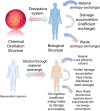How can aging be reversed? Exploring rejuvenation from a damage-based perspective
- PMID: 36619246
- PMCID: PMC9744548
- DOI: 10.1002/ggn2.10025
How can aging be reversed? Exploring rejuvenation from a damage-based perspective
Abstract
Advanced age is associated with accumulation of damage and other deleterious changes and a consequential systemic decline of function. This decline affects all organs and systems in an organism, leading to their inadaptability to the environment, and therefore is thought to be inevitable for humans and most animal species. However, in vitro and in vivo application of reprogramming strategies, which convert somatic cells to induced pluripotent stem cells, has demonstrated that the aged cells can be rejuvenated. Moreover, the data and theoretical considerations suggest that reversing the biological age of somatic cells (from old to young) and de-differentiating somatic cells into stem cells represent two distinct processes that take place during rejuvenation, and thus they may be differently targeted. We advance a stemness-function model to explain these data and discuss a possibility of rejuvenation from the perspective of damage accumulation. In turn, this suggests approaches to achieve rejuvenation of cells in vitro and in vivo.
Keywords: aging; biomarkers of aging; partial reprogramming; regeneration; rejuvenation.
© 2020 The Authors. Advanced Genetics published by Wiley Periodicals LLC.
Conflict of interest statement
The authors declare they have no conflicts of interest. [Correction added on 1 December 2020, after first online publication: Peer review history is not available for this article, so the peer review history statement has been removed.]
Figures






References
-
- Kirkwood TB, Melov S. On the programmed/non‐programmed nature of ageing within the life history. Curr Biol. 2011;21(18):R701‐R707. - PubMed
Grants and funding
LinkOut - more resources
Full Text Sources
